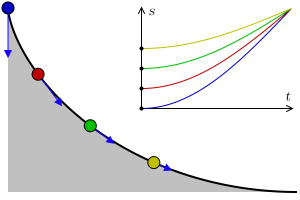A simple perspective for all fractional integro-derivative operators (FID) of this type is that they satisfy the group power sum property (law of exponents)
$$D_x^{\alpha}D_x^{\beta} = D_x^{\alpha+\beta}$$
and that their actions satisfy the dual translations
$$D_x^{\beta} \; H(x) \; \frac{x^{\alpha}}{\alpha!} = H(x) \; \frac{x^{\alpha-\beta}}{(\alpha-\beta)!} = D_x^{-\alpha-1} \; H(x) \; \frac{x^{-\beta-1}}{(-\beta-1)!} ,$$
where $H(x)$ is the Heaviside step function. This is consistent with the rep of this action as the convolutional integral rep of the Euler beta function analytically continued via the Pochhammer contour or the methods of generalized functions/distributions. See below and my response to the MO-Q "What's the matrix of logarithm of derivative operator (lnD)? What is the role of this operator in various math fields?" and the numerous links therein.
The Euler beta integral has a variety of physical, geometric, and probabilistic interpretations. See the MO-Q "Connections to physics, geometry, geometric probability theory of Euler's beta integral (function)".
Sinc function / cardinal series interpolation and a circular Fourier transform:
Let me summarize some old MO and MSE responses and blog notes for easy reference to relate the FIDs here to a Fourier transform on the circle and to hopefully clear up some confusion of this family of FIDs in fractional calculus with pseudo-diff ops/symbols related to Fourier transforms of continuous functions over the whole real line.
As mentioned above one (of several reps) for the action of the FIDs is the Euler beta integral rep
$$D_x^{\beta} \; H(x)\frac{x^{\alpha}}{\alpha!}= H(x)\int_{0}^{x}\frac{z^{\alpha}}{\alpha!} \; \frac{(x-z)^{-\beta-1}}{(-\beta-1)!}\; dz $$
$$= [ \; \int_{0}^{1}\frac{t^{\alpha}}{\alpha!} \; \frac{(1-t)^{-\beta-1}}{(-\beta-1)!} \; dt \;] \; H(x) \; x^{\alpha-\beta} .$$
Focusing on the Euler beta integral,
$$ \int_{0}^{1}\frac{t^{\alpha}}{\alpha!} \; \frac{(1-t)^{-\beta-1}}{(-\beta-1)!} \; dt $$
$$= \int_{0}^{1}\frac{t^{\alpha}}{\alpha!} \; \sum_{n=0} (-1)^n \frac{1}{n!\;(-\beta-n-1)!} \; t^n \; dt$$
$$ =\frac{1}{a! (-\beta-1)!} \sum_{n=0} (-1)^n \binom{-\beta-1}{n} \; \frac{t^{n+\alpha+1}}{n+\alpha+1} \; |_{t=0}^1$$
$$ = \frac{(-\alpha-1)!}{(-\beta-1)!}\; \sum_{n \ge 0} \binom{-\beta-1}{n}\; \frac{\sin(\pi \; (n+\alpha+1))}{\pi(n+\alpha+1)}$$
$$ = \frac{(-\alpha-1)!}{(-\beta-1)!} \; \sum_{n \ge 0} \binom{-\beta-1}{n} \; \binom{0}{n+\alpha+1} = \frac{(-\alpha-1)!}{(-\beta-1)!} \; \binom{-\beta-1}{\alpha-\beta} = \frac{1}{(\alpha-\beta)!} $$
with the last two lines valid for all complex $\alpha$ and $Re(\beta) < 0$. A Hadamard finite part extension of the beta integral to all $\alpha$ and $\beta$ can be constructed as on p. 68 of Generalized Functions Vol. I by Gel'fand and Shilov.
A quick change of variables, reflecting the desirable property
$$D_x^{\beta} \; H(x) \; \frac{x^{\alpha}}{\alpha!} = D_x^{-\alpha-1} \; H(x) \; \frac{x^{-\beta-1}}{(-\beta-1)!} = H(x) \; \frac{x^{\alpha-\beta}}{(\alpha-\beta)!},$$
gives
$$ \int_{0}^{1}\frac{t^{\alpha}}{\alpha!}\;\frac{(1-t)^{-\beta-1}}{(-\beta-1)!}\; dt = \int_{0}^{1}\frac{(1-t)^{\alpha}}{\alpha!}\;\frac{t^{-\beta-1}}{(-\beta-1)!}\; dt ,$$
with the binomial expansion and subsequent sinc function interpolation for the RHS valid for
all complex $\beta$ and $Re(\alpha) > -1.$
Since the domains of validity of the two different avenues of expansion overlap to give the same result at their intersection, we have via analytic continuation an expression valid for all $\alpha$ and $\beta$, real or complex,
$$D_x^{\beta} \; H(x) \; \frac{x^{\alpha}}{\alpha!} = D_x^{-\alpha-1} \; H(x) \; \frac{x^{-\beta-1}}{(-\beta-1)!} = H(x) \; \frac{x^{\alpha-\beta}}{(\alpha-\beta)!},$$
with the caveat (really an operator interpretation, see p. 57 of Generalized Functions Vol I (1964) by Gel'fand and Shilov)
$$H(x) \frac{x^{-n-1}}{(-n-1)!} = \delta^{(n)}(x) $$
with the standard Dirac delta interpretation
$$H(x) \int_0^x f(x-t) \; \delta(t) \; dt = H(x) \int_0^x f(t) \; \delta(x-t) \; dt = H(x) f(x).$$
A Cauchy integral rep gives the blow-up from the real line of the Euler beta integral to the complex plane, and, with a bit of regularization,
$$D_x^{\beta} \;H(x)\frac{x^{\alpha}}{\alpha!}= H(x)\frac{1}{2\pi i} \; \oint_{|z-x|=|x|}\frac{z^{\alpha}}{\alpha!} \; \frac{\beta!}{(z-x)^{\beta+1}} \;dz$$
$$ = [\; \frac{1}{2\pi i} \; \oint_{|z-1|=1}\frac{z^{\alpha}}{\alpha!} \; \frac{\beta!}{(z-1)^{\beta+1}} \;dz \;] \; H(x) \; x^{\alpha-\beta}$$
$$ = [\;\frac{1}{2 \pi} \int_{-\pi}^{\pi} (1+e^{i \theta})^{\alpha} \; e^{-i \beta \theta} d\theta \; ] \; \frac{\beta!}{\alpha!} \; H(x) \; x^{\alpha-\beta}$$
$$ = [ \; \sum_{n \geq 0} \binom{\alpha}{n} \; \frac{\sin(\pi \; (n-\beta))}{\pi(n-\beta)} \;] \; \frac{\beta!}{\alpha!} \; H(x) \; x^{\alpha-\beta} = H(x) \; \frac{x^{\alpha-\beta}}{(\alpha-\beta)!}.$$
Here, we have that the FID operation is equivalent to the Fourier transform over a circle (or an average of the Fourier transform of a periodic, in general piecewise continuous function over the real line)
$$\frac{1}{2 \pi} \int_{-\pi}^{\pi} (1+e^{i \theta})^{\alpha} \; e^{-i \beta \theta} d\theta.$$
Added 2/3/21: As noted in other posts, this family of FIDs is also derived by Pincherle through an axiomatic approach, praised by Wiener, and presented in eqn. 4 of "The Role of Salvatore Pincherle in the Development of Fractional Calculus" by Mainardi and Pagnini. It is also consistent with Heaviside's operational calculus.
(I recall seeing eons ago that Ramanujan explored this last integral. Anyone have a ref?)
You would have to remain only in a very small circumscribed domain of mathematics not to have often encountered FIDs in one of their avatars.
In addition to the Euler beta function integral above, which played a role in the birth of string theory, they are encountered as Kummer confluent hypergeometric functions (KCHF, a.k.a. generalized Laguerre functions), which lie at the heart of much of physics characterized by second order ODEs and vibrational analysis. The Hermite polynomials are one especially prominent example, found in diverse fields from number theory, group theory, probability theory, to the theories of heat diffusion and Riemann surfaces.
The KCHF in integral form is
$$ \frac{M(a,b,z)}{(b-1)!} = \int_{0}^{1}\frac{t^{a-1}}{(a-1)!} \; \frac{(1-t)^{b-a-1}}{(b-a-1)!} e^{zt} \; dt$$
$$ = D_{t=1}^{-(b-a)}\frac{t^{a-1}}{(a-1)!}e^{zt} = e^{z}D_{t=1}^{-a}\frac{t^{b-a-1}}{(b-a-1)!}e^{-zt}.$$
Similarly the Gaussian or ordinary hypergeometric function can be cast as
$$\frac{F(a,b;c;z)}{(c-1)!} = D_{t=1}^{-(c-b)}\frac{t^{b-1}}{(b-1)!}(1-zt)^{-a}.$$
Bessel functions can be related to FIDs as well.


